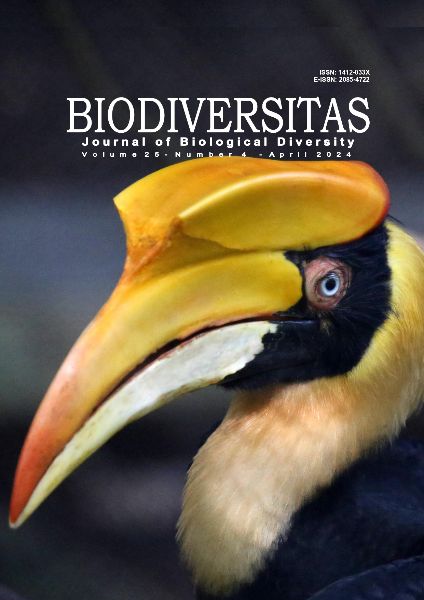Species composition and conservation of amphibians in Central Panay Mountain Range, Antique, Philippines
##plugins.themes.bootstrap3.article.main##
Abstract
Abstract. Flores GMA, Torres AG, Flores ABA, Jakosalem PGC, Guihawan JQ, Roa-Quiaoit HA. 2024. Species composition and conservation of amphibians in Central Panay Mountain Range, Antique, Philippines. Biodiversitas 25: 1797-1808. Assessing amphibian species composition and conservation status in Central Panay Mountain Range (CPMR), the largest contiguous forest in West Visayas in central Philippines, provides relevant and updated information on the status and conservation needs of the amphibians. Opportunistic, visual encounter and acoustic surveys were employed across diverse habitats-lowland and lower montane forests, streams, and grasslands. A total of 11 amphibian species from six families were documented, with notable findings including endemic species such as Rough-backed forest frog Platymantis corrugatus Duméril 1853, Dumeril’s wrinkled ground frog Platymantis dorsalis Duméril 1853, and Philippine narrow-mouth toad Kaloula conjuncta negrosensis Taylor 1922, as well as threatened species Panay forest frog Platymantis panayensis Brown, Brown and Alcala 1997, which is endemic to Panay Island. The P. dorsalis emerged as the most abundant, with 127 individuals recorded. Furthermore, two new distribution records of amphibians, narrow-mouth toad Kaloula sp. and panther flying frog Rhacophorus pardalis Günther 1858 were identified, potentially representing previously undocumented species endemic to the Philippines. The survey also revealed local threats posing significant risks to amphibian populations in the area. Several conservation measures have been proposed to protect amphibians and their habitats within CPMR. Given the area's rich biodiversity and ecological integrity, efforts are currently being implemented to establish CPMR as a nationally protected area, and this study contributes to this initiative by providing baseline data on amphibian diversity, underscoring the role of amphibians as ecological indicators of ecosystem health.
##plugins.themes.bootstrap3.article.details##
Most read articles by the same author(s)
- HEIZEL MAE O. MAHILAC, JOYLINBER P. TANDINGAN, ARMI G. TORRES, RUBEN AMPARADO JR, HILLY ANN ROA-QUIAOIT, Macroinvertebrate assessment in seagrass ecosystem in Sinacaban Municipality, Misamis Occidental, Philippines , Biodiversitas Journal of Biological Diversity: Vol. 24 No. 10 (2023)
- LARRY C. HERBITO JR., JAIME Q. GUIHAWAN, CHRISTINE MARIE V. CASAL, DAISY LOU L. POLESTICO, ARMI G. TORRES, Unveiling the prevalence of invasive alien plant species in multiple-use zone of Initao-Libertad Protected Landscape and Seascape, Misamis Oriental, Philippines , Biodiversitas Journal of Biological Diversity: Vol. 25 No. 9 (2024)


 https://orcid.org/0009-0004-3938-1426
https://orcid.org/0009-0004-3938-1426